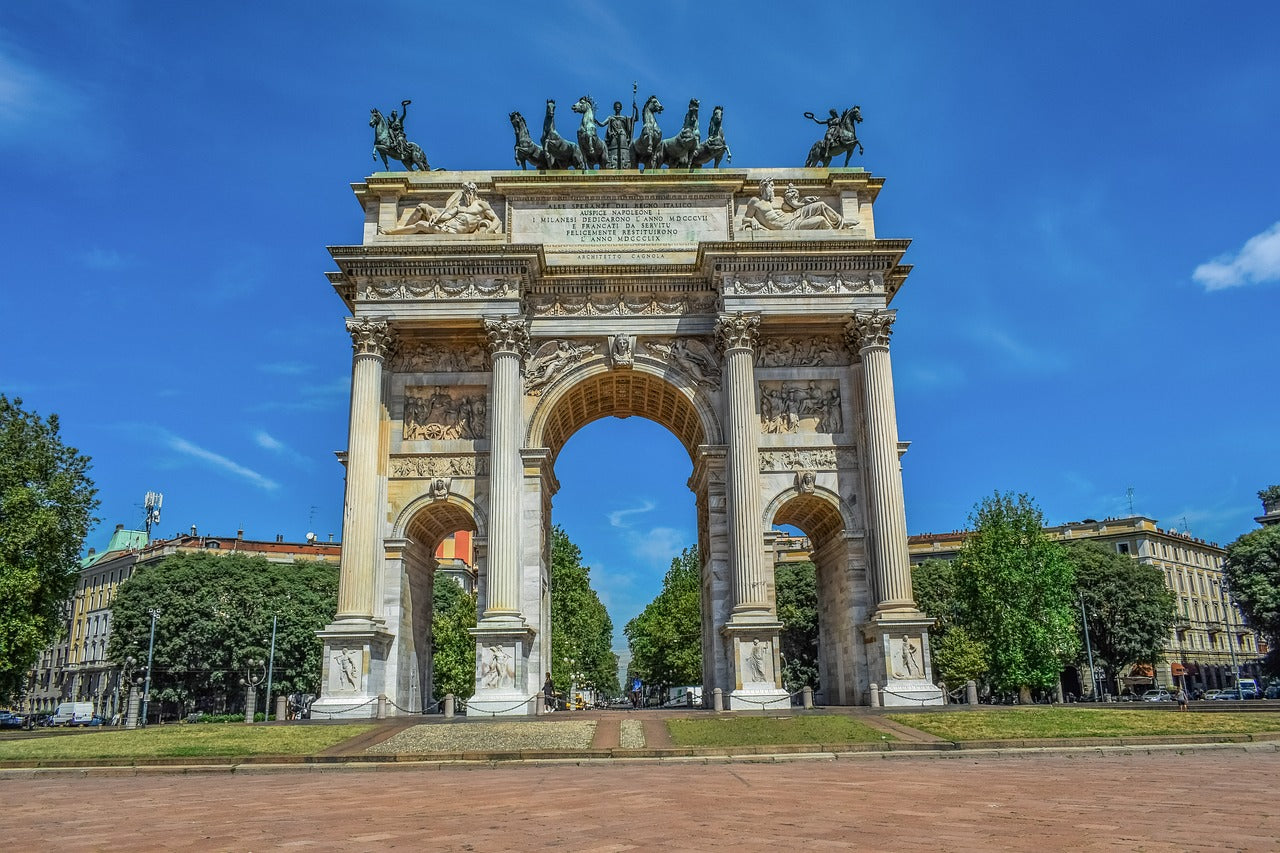With its great historical significance, the Arco della Pace is one of the symbols of Milan: a triumphal arch located behind the Castello Sforzesco which towers over the circular plaza at the end of Parco Sempione. A very impressive monument, it is an emblem of the historical importance and majestic appearance of the city, while also interpreting new forms of social interaction and the Milanese lifestyle. The perfect crossroads between tradition and innovation, the point where the city's various souls converge.
The Arco della Pace of Milan: a step back in time
The current Arco della Pace was inspired by an ephemeral arch built in 1806. Made with wood, plaster and canvas, it stood on what was then Corso di Porta Riconoscenza, today's Corso Venezia. The original arch was a temporary construction to welcome the newlyweds Eugene de Beauharnais, viceroy of Italy and son of Napoleon, and Augusta of Bavaria. It was so successful that the city council decided to build a large marble arch in a more suitable location.
Like the temporary construction, to which it was very similar, the new arch was designed by Luigi Cagnola. Work began in 1807, where the countryside behind the Castello Sforzesco used to be, the present-day Piazza Sempione, to celebrate France's victory over the Germans at the Battle of Jena a year earlier. However, the Kingdom of Italy fell in 1814 and despite being almost finished, construction work came to a halt, resuming only in 1826 under the Habsburg Emperor Francis I of Austria, who changed its designation from “Arch of Victory” to “Arch of Peace”.
The Arco della Pace is in fact dedicated to the peace between nations achieved with the Vienna Congress of 1815. With the death of Luigi Cagnola in 1833, the direction of the work passed to Carlo Giuseppe Londonio, who completed it in 1837.
The victory of Magenta in 1859 sanctioned Milan's freedom from the Austrians: Napoleon III and Victor Emmanuel II passed under the Arco della Pace to celebrate this historic moment.
From then on, the Arco della Pace became a true symbol of Milan, like Milan Cathedral and the famous Via Monte Napoleone.

An ode to neoclassical style in Piazza Sempione
Walking up to the Arco della Pace is always a breathtaking experience because the monument towers over you with its grandeur and solemn, majestic air: the façade measures 25 metres high by 24 metres wide, with the largest arch measuring 14.24 metres. Milan's Arco della Pace is similar to but more richly decorated than the famous Arc de Triomphe in Place Charles de Gaulle in Paris, also built between 1806 and 1836.
The Milanese monument is actually made up of three arches with four fluted columns with Corinthian capitals. Made of Baveno granite and clad in Crevoladossola stone, the arch is surmounted by Abbondio Sangiorgio's “La Sestiga della Pace”, six bronze horses positioned in the middle pulling the chariot of the Goddess of Peace, and by four galloping Victories by Giovanni Putti set in the corners.
The façade is finely decorated with marble bas-reliefs depicting various moments in history, as well as statues of deities, works representing arts and crafts and sculptures representing the Po, Adige, Ticino and Tagliamento rivers.
Also in Piazza Sempione, on either side of the Arch, are the two toll houses that served both to collect duties and to distinguish the urban territory from the countryside and which, together with the Arch, form Porta Sempione.
Arco della Pace: a place for meetings, events and socialising
The Arco della Pace is located at the gates of Milan's biggest park, Parco Sempione, the perfect place to escape the summer heat, do outdoor sports, take your kids to play and enjoy some peace and quiet. And you can do much more here than simply walk. The very large plaza has always been a meeting place. The programme of concerts at the Arco della Pace is always very rich and numerous events, political and otherwise, take place beneath it.
Whether it's for happy hour with friends, a business lunch, a romantic dinner or dancing the night away, there are several restaurants and clubs near the Arco della Pace that make the area a reference point for the city's nightlife.

